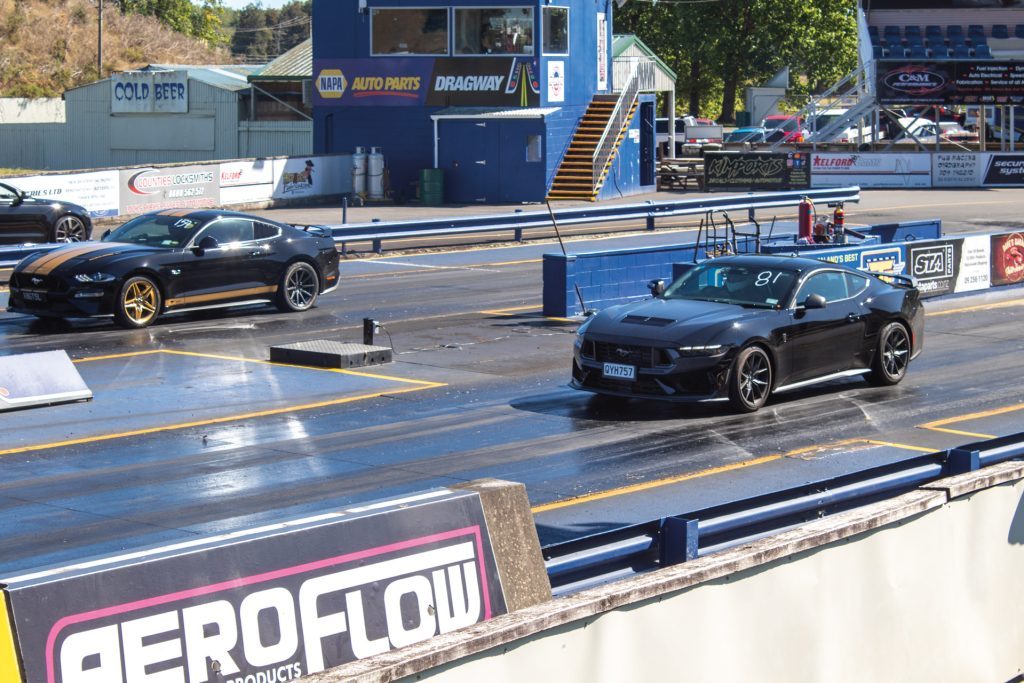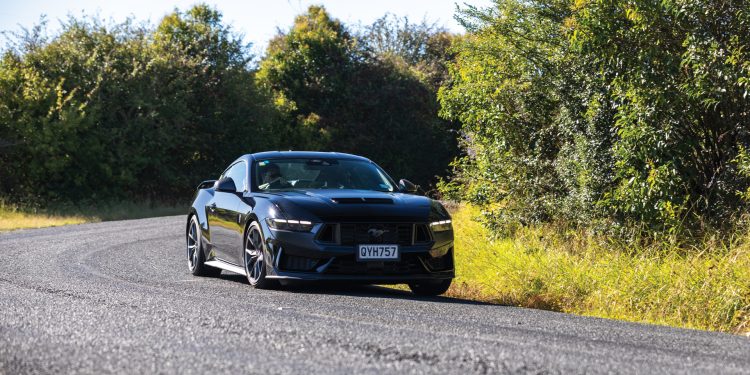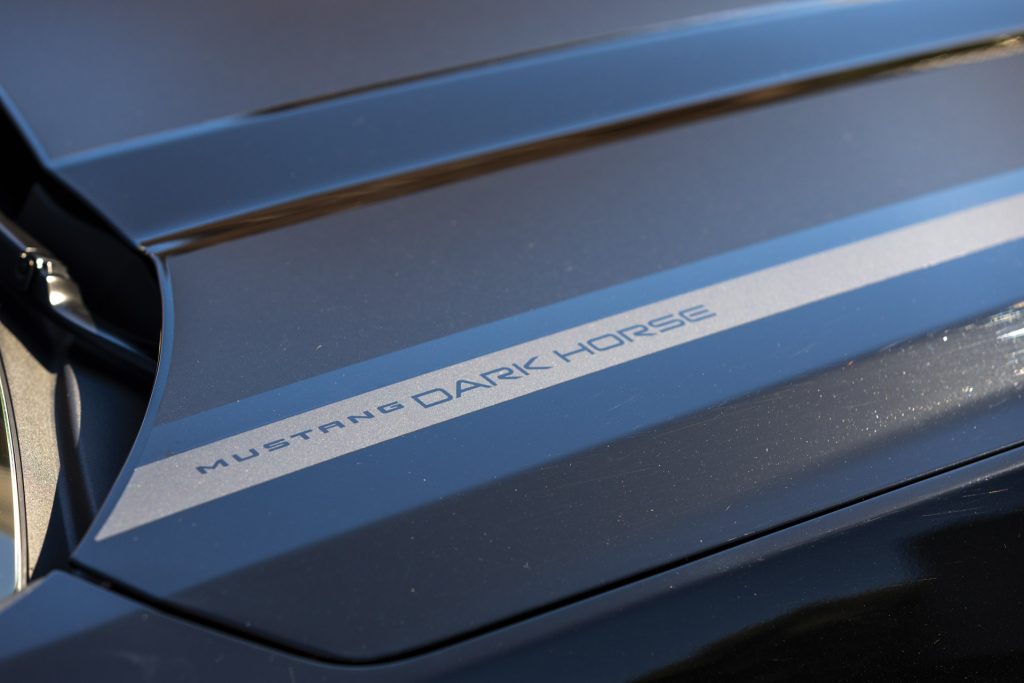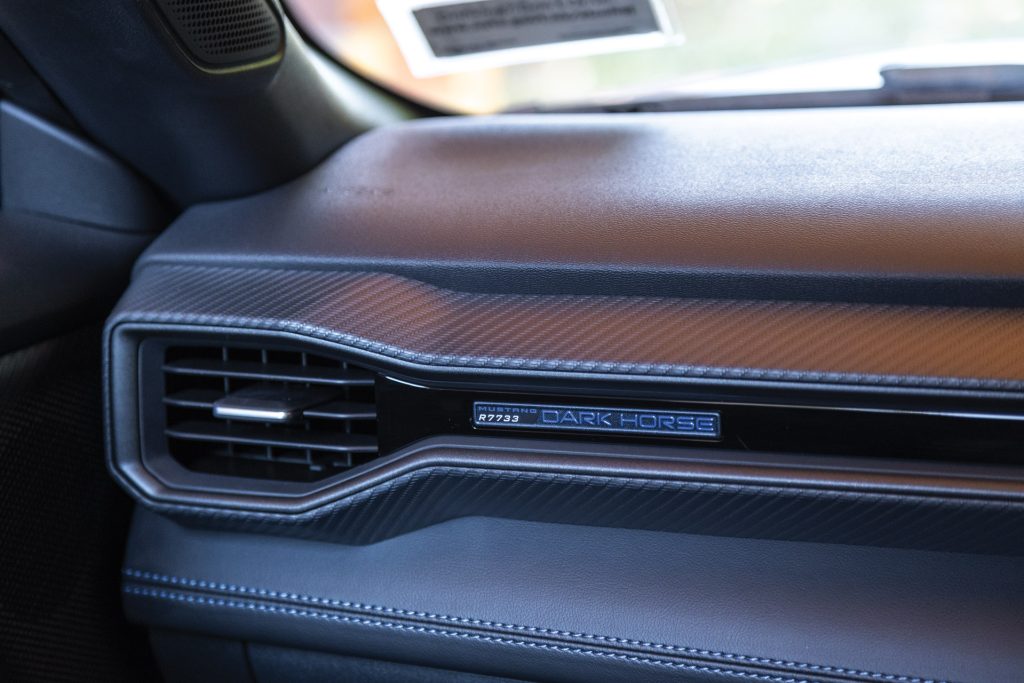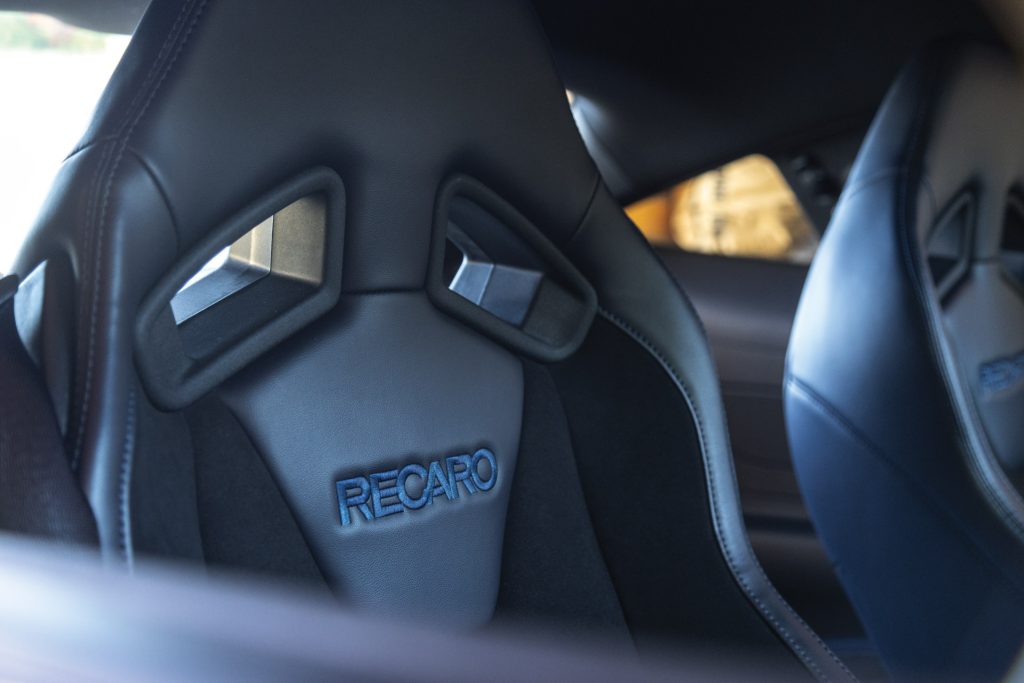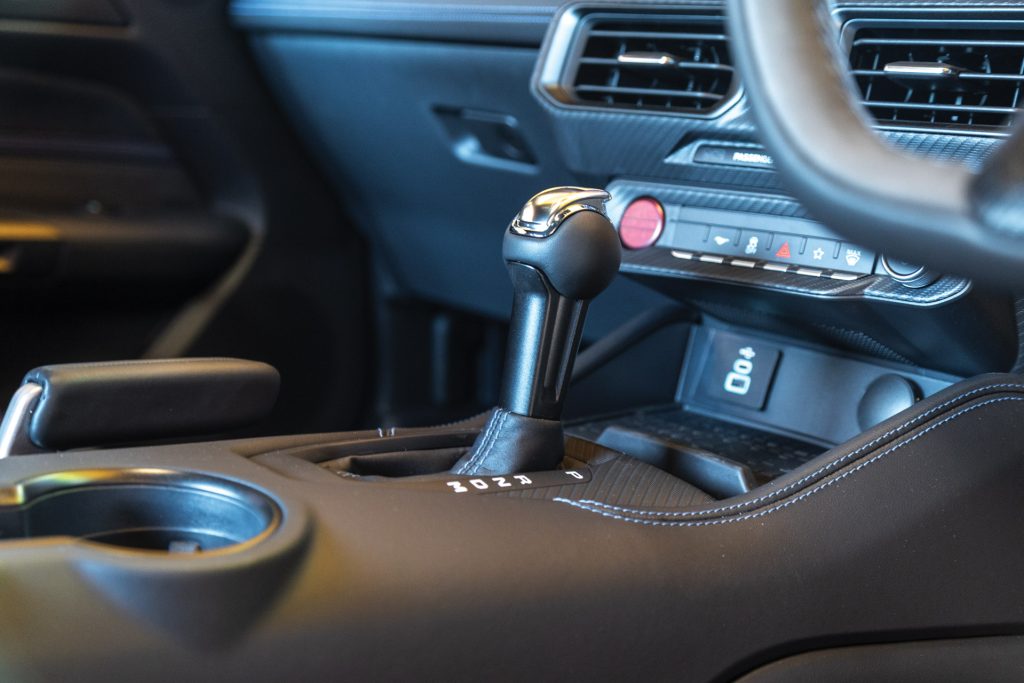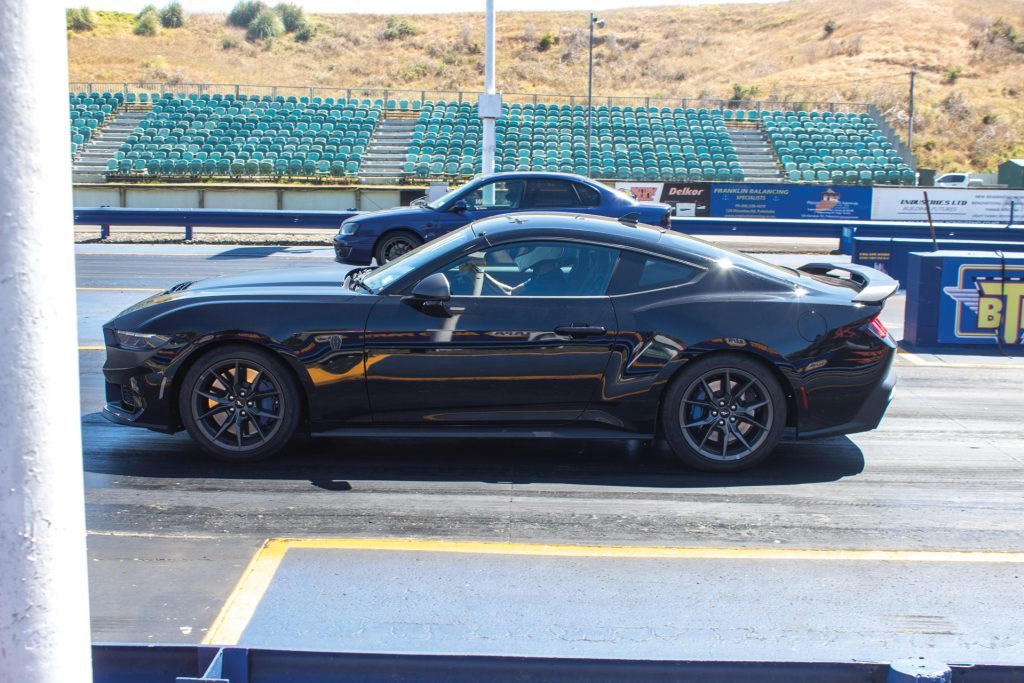2025 Ford Mustang Dark Horse Review
Words: Kyle Cassidy | Photos: Alex Schultz
Ford’s Mustang Dark Horse is a polished piece of kit, at home both on road and track. It’s a sell-out, NZ’s allocation exhausted. So was it worth its premium over the regular old GT?
The Mustang Dark Horse is a rare breed here. Ford New Zealand decided to make it a limited affair for Kiwis, restricting the herd size to 150 head. The Dark Horse is currently the top Mustang one can aspire to but it’s not a limited model in its home market, rather the top stallion. However, making it exclusive helped move them quick smart here, and now they’ve all gone. This then is the unobtainable one, although you can find the odd example mooching about on Trade Me, usually with a premium over the original asking price.
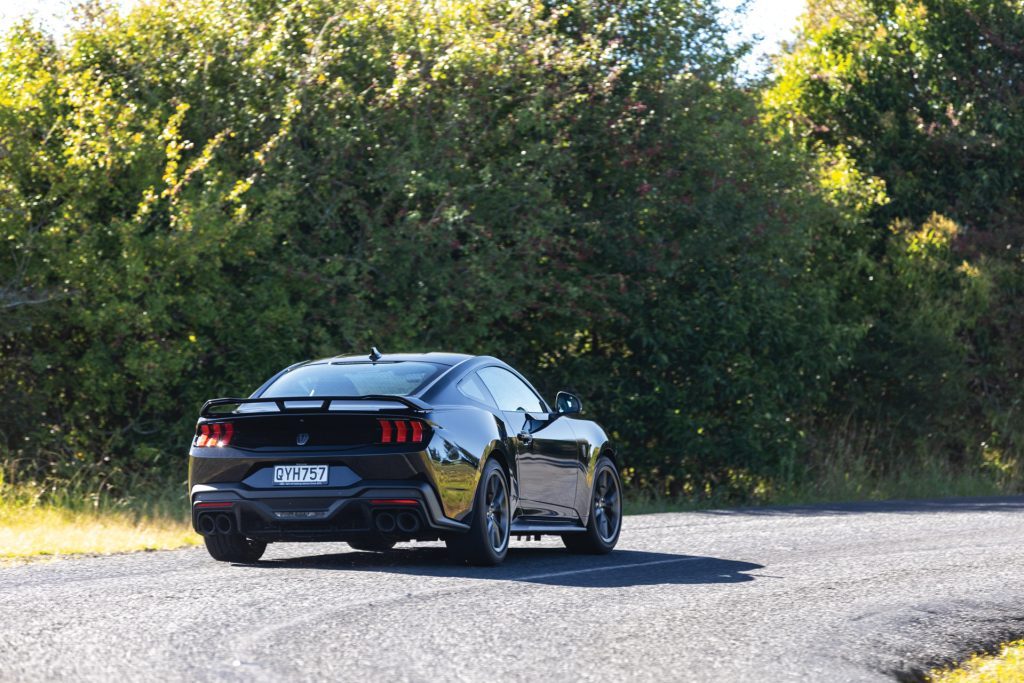
A Dark Horse?
The Dark Horse (DH) is a step up on the standard GT, itself renewed in this S650 seventh generation of Mustang. While the underpinnings aren’t fundamentally changed, it gets some updates like a steering ratio tweak, suspension improvements and better brakes.
And then the DH adds to that. The standard Coyote 5.0, now in its fourth generation, gets dual intakes and twin throttle body induction while the DH gains forged rods and a balanced crankshaft to help it spin. The active-valve performance exhaust bumps power up from the standard GT’s 362kW to 373kW, or 500 horses in old money. Torque remains at 567Nm, although those numbers are made on 98 octane.
The chassis tweaks include larger rear sway bars, a strut tower and K brace under the bonnet and heavy-duty front shocks with standard MagneRide adaptive dampers. You get a Torsen diff and Pirelli P Zeros too.
Not that you can see them on this black car (that we were forever cleaning) but you get darkened details and graphics about the body.
The GT’s new skin is more aero efficient, while the DH gains a spoiler kit. It’s the only NZ-spec Mustang to come fitted with Recaro seats as they are no longer available as an option on the GT. And it was the only way to secure a manual transmission, also no longer available on the GT. The six speed is the same as used by the GT350, the swift shifting Tremec TR 3160, with a shorter final drive to help acceleration. There are more cooling ducts and oil coolers for the engine and rear axle, and there’s a better radiator.
At a trot
The DH might be track-focused but it’s every-day friendly. The ride has a smidge of firmness in the Normal drive mode (one of five), about what you’d expect from a sports car like this. Its steering has three assistance settings, Normal being on the hefty side for urban use, but there is a lighter ‘feather’ mode as well, relieving some of the weight. It doesn’t ride too low, but some caution is needed with that front spoiler in car parks and on steeper driveways. The Torsen diff will bind up a little on tight slow turns, and, when a rear wheel unloads (usually on those tricky driveways), it’s a bit slow to redirect drive to the wheel with grip. That exhaust is nice and loud, though there is a quiet mode as well.
The interior update sees two-thirds of the dash taken over by screens. Its 12-inch digital instrument cluster has myriad themes and layouts, including dials from Mustang models of the past. The 13-inch Sync screen runs the show, which you shouldn’t find hard to operate with a logical layout and quick enough response. Mustang has a good back-up camera, but no surround view. There’s a smart key for easy unlocking. The rear seats are useful for kids, though even they find the access difficult. Apart from the tight opening, the boot capacity surprises; it’s quite cavernous in there for a sportster.
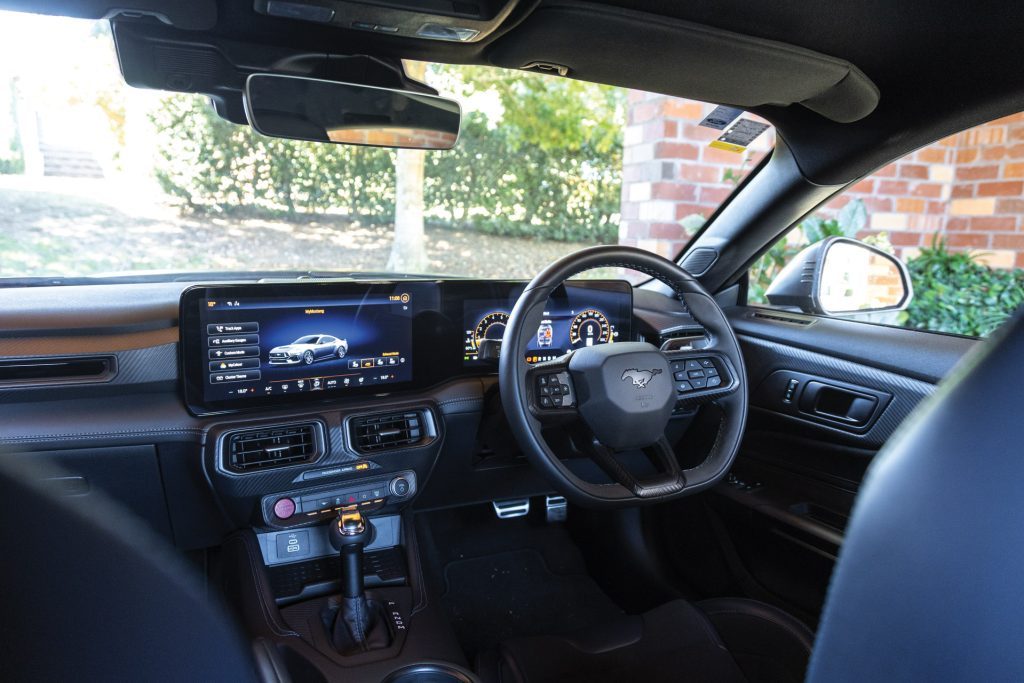
At a canter
The highway ride is okay but the tyre noise gets rowdy on really coarse chip. Not enough to drown out that 5.0 rumble though. The 10-speed sets the V8 to cruise around 1800rpm, and it’s about the only time its appetite for fuel is calmed. Think mid-teens for town work, 11s on the highway and much more when going for a gallop. The active cruise does its job okay but the lane keeping needs to be sorted. Not because it’s meddling with the steering (only occasionally, and usually because you have strayed over the line) but rather it keeps issuing a warning to keep your hands on the wheel. Even though that’s where they are! Kill the lane keeping (easily done without having to go near the touchscreen), and it all stops.
At a gallop
They call the DH the most track-ready Mustang ever, yet it’s also pretty handy on road. Click into Sport mode (now much easier in Mustang with a new toggle switch on the wheel) and the MagneRide dampers add a notch more control. The steering also adds some meat and the powertrain is more up for it. Here the ten-speed will hold its gears just long enough, and it’s quick yet surprisingly smooth with its upshifts. Snappier shifts come in Track (and even more intense in the Drag mode) but the suspension gets too intense for road use in this mode.
So Sport it is. Left in D, there’s a reluctance to drop a cog or two when braking for a bend. Round up the curve and then look for the power on the exit and it’s not quite queued up, forcing the box to rapidly kick down on the way out. Hmm, that’s not quite how we like it. While the protocols did start to adapt and initiate a downshift under braking, it was still a tad inconsistent. And so we took to paddling it, playing with third, fourth and fifth.
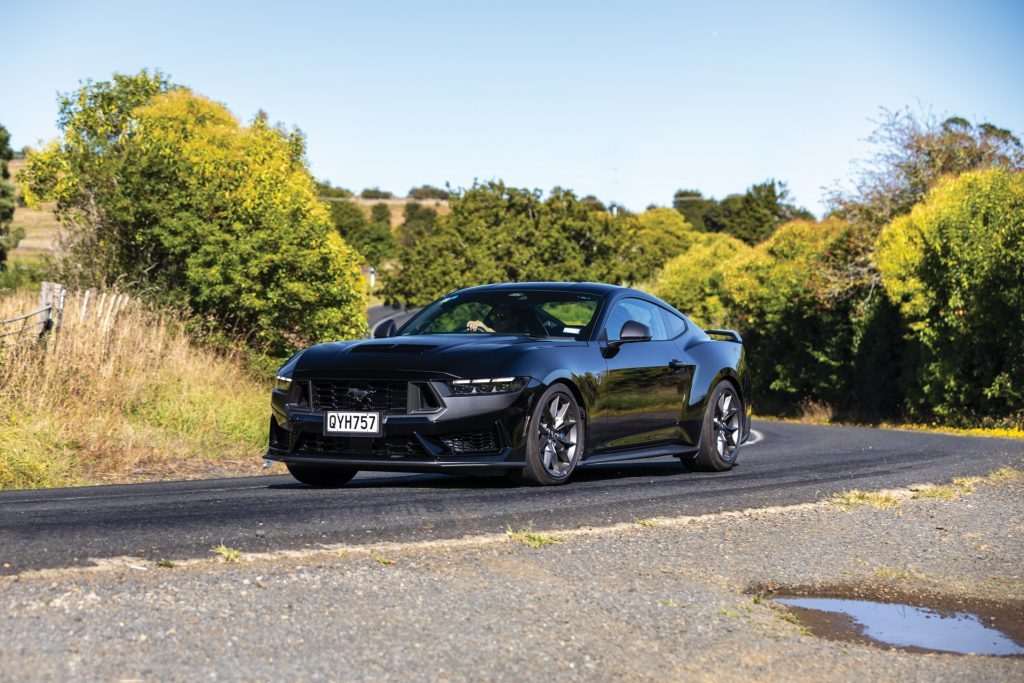
With its tauter suspension settings, the roll, squat and dive are all well tamed, while the ride isn’t too harsh either. Only upon thumping into those nasty humps do you wonder if a dram of additional compliance might be nice. This sticks well though, the front tyres taking cornering loads in their stride. And the rear lays on enough traction as well; rarely does the T/C light flicker. The brakes rein it in too, the pedal action precise. As is the control of the weight transfer. That helps meld everything together in the turns. The DH likes a traditional front engine, rear drive approach with a dab of brakes to help load up the front and assist the turn in and then you squeeze the gas on ready to nail it on the exit. The DH is a sorted driver.
You know you’ve had a good time out when the numbers on the G metre gauge are reading 1.1 in each direction. There’s not the traction to pull a gee of acceleration though. Ford says the DH will hit 100 in 4.6sec, and it’s easy enough to dip under five, harder to get closer to the claim. Manual cars get a launch control function but not the auto. Here you must balance stalling it up a little on the brake and then ease into it as quickly as you can without the rears developing an excess of rotation. This thing really wants to create some smoke if you are too hasty.
Definitely worthy?
Certainly is. If you missed out this time around, don’t fret. If previous form is anything to go by, there will be more special edition Mustangs to fill out the S650 generation. These will probably borrow bits from the Dark Horse catalogue, or even build on the package. You’ll just have to be quick to corral one.
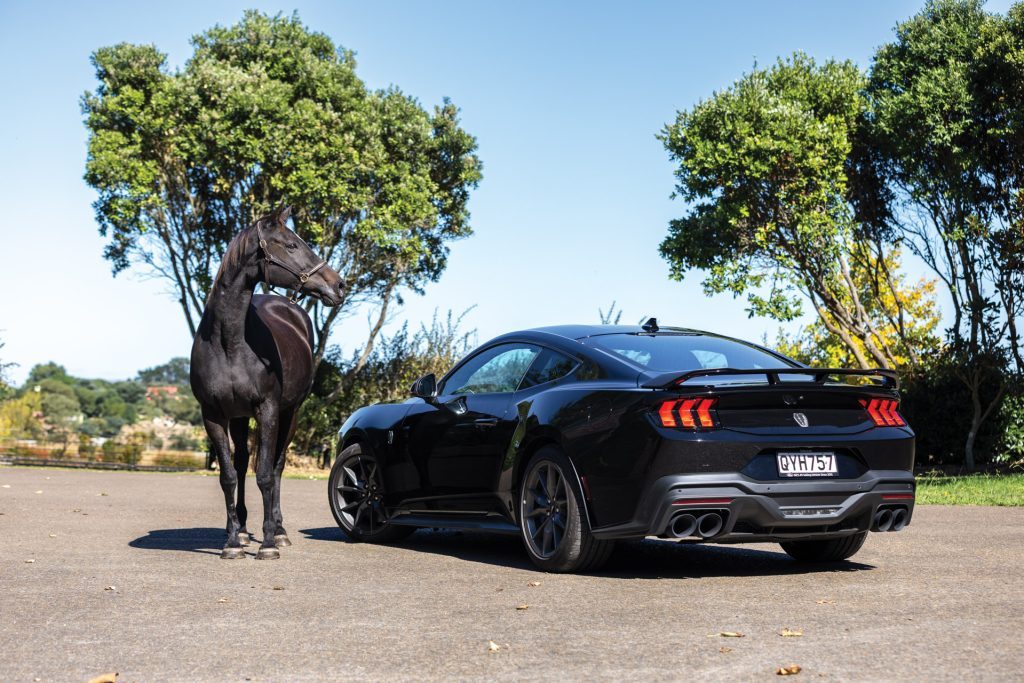
Ford Mustang Dark Horse
$116,990 / 13.8L/100km / 322g/km
0-100 km/h 4.70s
80-120 km/h 2.40s (72m)
100-0 km/h 33.98m
Speedo error 98 at an indicated 100km/h
Ambient cabin noise 75.5dB@100km/h
Engine 5038cc / V8 / DI
Max power 373kW@7250rpm
Max torque 567Nm@4900rpm
Drivetrain 10-speed auto / RWD
Front suspension Mac strut / sway bar
Rear suspension Multilink / sway bar
Turning circle 12.2m (2.2 turns)
Front brakes Ventilated discs (390mm)
Rear brakes Ventilated discs (355mm)
Stability systems ABS, ESP
Safety AEB, ACC, BSM, LDW, RCTA, ALK, AHB
Tyre size f-245/40R19 r-275/40R19
Wheelbase 2719mm
L/W/H 4819 / 1917 / 1403mm
Track f-1579mm r-1623mm
Fuel capacity 60L
Luggage capacity 376L
Tow rating Not rated to tow
Service intervals 12 months / 15,000km
Warranty 5yrs / unlimited km
ANCAP rating Not rated
Weight (claimed) 1811kg
Dark Horse at the drags
After having sampled the Dark Horse on both road and race track, the latter at the Australasian launch (Bend Motorsport Park), we thought we should try it at the strip in order to get a handle on its ‘total performance’ quotient. Joining a non-competitive but timed event at Meremere Drayway, it was a good opportunity to try out the Drag Strip mode at least.
Mustang’s have a long drag racing pedigree; almost as soon as it launched in the US in the mid-sixties, drag racers were tuning them up for a life on the strip. So important was performance away from the lights that Ford used it as spin to help justify the retention of a solid rear axle for the fifth-gen S197. Ford suggested drag racing enthusiasts preferred such a set-up over a multilink arrangement.
Eventually the bean counters let the engineers design a Mustang with a multilink rear end, debuting on the sixth-gen S550. When this model was updated in 2018, along with the addition of the ten-speed auto, Ford also introduced us to the Drag Strip setting, which is still part of the selection here too.
As you toggle through the Mustang’s modes, the graphics on the driver display change from the Dark Horse hugging the circuit kerbing in Track mode to it lining up in front of the Christmas tree in Drag Strip mode, complete with smoke billowing off the rear tyres. Hopefully that’s when the car is in the waterbox, warming the rubber before staging for that perfect 60ft time. Set this way, the auto’s shifting protocols really step up a notch, the timing barely retarded as each ratio is snapped through quick smart. This keeps the flow of toque streaming in the quest for the quickest elapsed time down the strip. The traction control is switched out so it doesn’t get in the way and the dampers are set to Track mode, their firmest setting in order to manage the squat as you power on out of the staging area.
Lining up for the first time, inching forward to get the staging lights illuminated, there’s a few nerves as you try to remember to get going just before the light goes green in order to bag a good reaction time. But as you see the last white light flashing, out of the corner of your eye you also notice the car in the other lane is already rising up as it starts powering out of the blocks. I’m already behind, and go a bit hard on the gas pedal. With a prepped staging area, the tarmac sticky with traction enhancing compound, the grab off the line is solid but there’s still a bit of scrambling from the rears. As the auto plucks second gear, the rear tyres chirp again and our head nods as the shift shock is quite savage in Drag mode. We’ve no real chance of catching our opponent, it’s a supercharged S550, and it ends up beating us by more than a second, as we turned in a 12.9sec quarter mile pass. Thankfully things get better over the next few runs.
Horsepower wins races at the strip, but it has to be balanced with traction. Many of the cars on the day from the Ford and Holden (thou shalt not be forgotten) camps had a helping of supercharged induction to ramp up the pony count. And the balance was provided with a set of drag radials on the rear end to help make it all stick.
You’d imagine 500 horsepower would be enough to win your fair share of races, but with the proliferation of blown cars on the strip touting 700 plus, even the Dark Horse was a little underdone.
But still we kept on. After a bit of delay to clean up the track after someone launched the AWD rocketship too hard off the line, we were back into it. Our reaction time improved the second time out, down from 0.250 to 0.154sec, and with just a little less enthusiasm on the gas pedal off the mark, the 60ft time improved as well, which meant a quicker quarter time of 12.54sec. But again, a supercharged Holden had us beat by a second.
Our third run netted the best reaction time of 0.061sec, and up against a naturally aspirated V8, it proved the difference with a narrow win of at 12.68sec. Our final run of the day was a 12.6sec pass but, after a fluffed start, the turbocharged opposition still managed to fly past us with the finish line mere metres away. Ah well. We could have got a few more runs in, the Dark Horse happy to oblige, but the kids had seen enough burnouts and action for the day, so we headed off.
In all, it was a solid showing from the showroom standard Dark Horse against all the modified machinery. And we happily went off knowing it would have been a different story had we headed up the road to Hampton Downs for a few laps. There, the Dark Horse would really shine.
